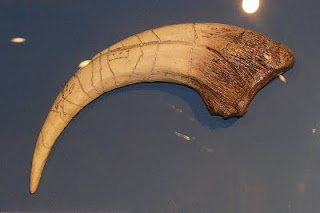By now, all dino fans have probably heard the buzz on the indicator: Jack Horner and team are working on a paper which attempts to prove that Torosaurus and Triceratops are the same thing, and that in general, growth series in dinosaurs are often misinterpreted as numerous similar species (something that has long been acknowledged in pterosaurs and recently in early birds like Archaeopteryx and, probably, Confuciusornis).
Here's the quick and dirty background: Triceratops was named by O.C. Marsh in 1889 based on a pair of horns and skull roof collected in 1887 from Colorado. Numerous complete specimens followed, making Triceratops the archetypal horned dinosaur with its two long forward-pointing brow horns and single short, forward-pointing nose horn, in front of a relatively short (by ceratopsian standards), solid frill. The frill is notable: most ceratopsians, including close relatives of Triceratops, have long frills with large openings, or fenestrae, in the bone.
Torosaurus was described a few years later in 1891, also by Marsh, based on two skulls. Unlike Triceratops, the Torosaurus skulls had long frills with the standard fenestrae. Its frill was also smooth around the edges: many Triceratops specimens show that they had small, bony scutes adorning the frill's edge, called epoccipitals.
According to Horner's talks at SVP, which he also summarized in an interview on the podcast The Skeptic's Guide to the Universe (available here), those differences are not due to species variation, or even sexual dimorphism as previously hinted. Rather, Torosaurus is nothing more than the most mature growth stage of Triceratops. The paper isn't out yet so all the data isn't available, but presumably Horner will demonstrate based on microscopic bone growth studies that all the specimens currently assigned to Triceratops are not fully mature, and that like modern birds, some secondary sexual characteristics (such as the expanded, chasm-filled frill) pop up quite suddenly at the 'last minute' in the animal's growth, after it has already reached nearly adult size.
We can already see heaps of major changes taking place as Triceratops grows. Juveniles have backward curving horns, which completely change to point forward during growth. Remember those epoccipital fringes, the lack of which is so diagnostic of Torosaurus? We already see them becoming reduced from tall, pointed osteoderms in younger forms to smooth and rounded, and finally merging with the frill itself and smoothing out so as to be almost invisible. Indeed, in these oldest individuals, the bone in the center of the frill can also be seen to thin like a man's receding hairline. Given that we already know all of this about Trike's growth, it's not a very huge leap to recognize a long, smooth, holy frill as the next logical step, and those just happen to have been named Torosaurus for 110 years.
The goss has been flying over this online, and a few interesting tidbits have come up. Having grown up in the Northeast US, the most interesting to me concerns the mistaken identity of some specimens of Triceratops. For me, the quintessential Triceratops is the one in the American Museum of Natural History (specimen AMNH 5116). However, as many have pointed out on DinoForum and elsewhere, it's also among the most... well, un-Triceratops like.
 Above: Triceratops skull 'classic' vs. specimen AMNH 5116. By Ed T. and Michael Gray (right), licensed.
Above: Triceratops skull 'classic' vs. specimen AMNH 5116. By Ed T. and Michael Gray (right), licensed.Compare the images above. On the right is my beloved AMNH Trike. On the left is a 'classic' Triceratops skull. The frill on the AMNH specimen is longer, and lacks epoccipitals. The frill is also tall and back-swept, not flared out to the sides, as in most Triceratops skulls. Not only that, but as you can see in the image at the top of this post (which is a more contrasty view of the same AMNH skull), almost all of the frill has been restored in plaster to conform with what a Trike should look like. There are significant gaps in the middle of the frill entirely filled with plaster... exactly where the fenestrae of Torosaurus go. If Torosaurus and Triceratops are indeed separate species, the AMNH Trike is no Trike at all... it's a Torosaurus in disguise!
Thankfully, it's more than likely that there is no such thing as Torosaurus, any more than there was a Brontosaurus. It's all Triceratops baby, and we can conclude that this famous last of the ceratopsians was indeed last, the only one of its kind in the Lance and Hell Creek Formations that date to the very end of the Mesozoic era.
But... wait... isn't there another named ceratopsian from the same time and place? Named BEFORE Triceratops?? If there was only one Lance/Hell Creek ceratopsian, then Torosaurus get sunk into Triceratops as a synonyms. Does Triceratops then have to be abandoned in favor of... Agathaumas!?
Dun dun duuuuuun!





